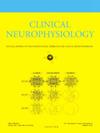Utility of neuromuscular ultrasound and comparison of NMUS with electrodiagnostic tests in dominant spinocerebellar ataxia
IF 3.7
3区 医学
Q1 CLINICAL NEUROLOGY
引用次数: 0
Abstract
Objective
To estimate and compare the prevalence of sensory neuronopathy and neuropathy in autosomal dominant spinocerebellar ataxia (SCA) using neuromuscular ultrasound (NMUS) and traditional electrodiagnostic tests (EDX).
Methods
We compared NMUS [median and ulnar nerve cross-sectional areas (CSAs)] with EDX [sensory (sural, radial, median, ulnar); motor (median, ulnar, tibial)] findings from previously published and newly recruited patients with SCA (44 in total; SCA1 = 8, SCA2 = 27, SCA3 = 2; SCA6 = 7).
Sensory neuronopathy was diagnosed by reduced nerve CSA on NMUS and non length-dependent sensory axonal pattern on EDX, and neuropathy by enlarged nerve CSA on NMUS and length-dependent axonal pattern on EDX.
Results
Abnormalities were detected significantly more frequently on NMUS than EDX (75 % vs 51 %, p < 0.001), especially sensory neuronopathy (57 % vs 32 %; p < 0.001). Ten of 24 sensory neuronopathies detected by NMUS were missed by EDX. No sensory neuronopathy detected by EDX was missed by NMUS.
Conclusions and significance
The prevalence of abnormality, especially sensory neuronopathy, detected in our SCA cohort was significantly higher with NMUS than EDX.
This has significant implication for clinical practice. Where NMUS resources are available, NMUS can be proposed as the method of choice for the investigation of sensory neuronopathy in SCA.
神经肌肉超声在优势型脊髓小脑共济失调中的应用及NMUS与电诊断试验的比较
目的应用神经肌肉超声(NMUS)和传统电诊断试验(EDX)评估和比较常染色体显性脊柱小脑性共济失调(SCA)患者感觉神经病变和神经病变的患病率。方法比较NMUS[正中和尺神经横截面积(csa)]与EDX[感觉(腓肠、桡骨、正中、尺骨)];先前发表的和新招募的SCA患者(共44例;Sca1 = 8, sca2 = 27, sca3 = 2;sca6 = 7)。NMUS上的神经CSA减少和EDX上的非长度依赖性感觉轴突模式诊断为感觉神经病变,NMUS上的神经CSA增加和EDX上的长度依赖性轴突模式诊断为神经病变。结果NMUS的异常检出率明显高于EDX (75% vs 51%, p <;0.001),尤其是感觉神经病变(57% vs 32%;p & lt;0.001)。NMUS检测到的24个感觉神经病变中,EDX遗漏了10个。NMUS未遗漏EDX检测到的感觉神经病变。结论和意义:在我们的SCA队列中,NMUS检测到的异常患病率,特别是感觉神经病变,明显高于EDX。这对临床实践具有重要意义。在有NMUS资源的地方,NMUS可以作为SCA感觉神经病变研究的选择方法。
本文章由计算机程序翻译,如有差异,请以英文原文为准。
求助全文
约1分钟内获得全文
求助全文
来源期刊

Clinical Neurophysiology
医学-临床神经学
CiteScore
8.70
自引率
6.40%
发文量
932
审稿时长
59 days
期刊介绍:
As of January 1999, The journal Electroencephalography and Clinical Neurophysiology, and its two sections Electromyography and Motor Control and Evoked Potentials have amalgamated to become this journal - Clinical Neurophysiology.
Clinical Neurophysiology is the official journal of the International Federation of Clinical Neurophysiology, the Brazilian Society of Clinical Neurophysiology, the Czech Society of Clinical Neurophysiology, the Italian Clinical Neurophysiology Society and the International Society of Intraoperative Neurophysiology.The journal is dedicated to fostering research and disseminating information on all aspects of both normal and abnormal functioning of the nervous system. The key aim of the publication is to disseminate scholarly reports on the pathophysiology underlying diseases of the central and peripheral nervous system of human patients. Clinical trials that use neurophysiological measures to document change are encouraged, as are manuscripts reporting data on integrated neuroimaging of central nervous function including, but not limited to, functional MRI, MEG, EEG, PET and other neuroimaging modalities.
 求助内容:
求助内容: 应助结果提醒方式:
应助结果提醒方式:


